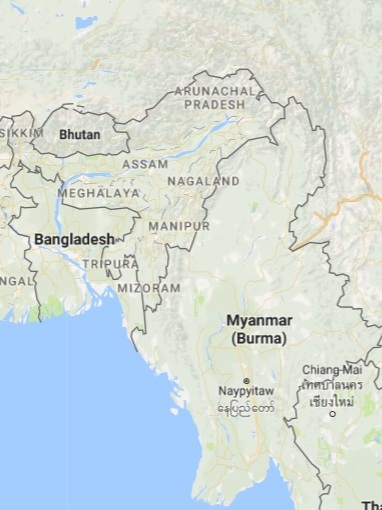Profile
Profile
The UGC Centre for Studies on Bangladesh and Myanmar (CSBM), at Dibrugarh University, was established in 2005, under the University Grants Commission’s (UGC) Area Studies Programme in its X Plan period (2002-07), to promote multi-disciplinary research on Bangladesh and Myanmar.  The need for such a specialised Centre arose out of a historic necessity to harness the age-old links which India’s North-eastern Region (NER) shared with the neighbouring regions of South, Southeast and Inner Asia, mostly through a web of land and sea routes collectively referred to as the Southern Silk Route (SSR) since at least the 2nd millennium A.D.
The need for such a specialised Centre arose out of a historic necessity to harness the age-old links which India’s North-eastern Region (NER) shared with the neighbouring regions of South, Southeast and Inner Asia, mostly through a web of land and sea routes collectively referred to as the Southern Silk Route (SSR) since at least the 2nd millennium A.D.
Today, when borders are increasingly turning soft owing to the rapid strides in connectivity, both physical and digital, it is imperative that one keeps abreast with the continuing changes taking place globally and in the neighbourhood. The technological advances ushered in by Globalisation are increasingly turning the world into a global village and the region comprising Bangladesh, Myanmar and the NER, forming a natural geo-economic unit, needs to reap the benefits of such changes. With their huge coastlines, both the countries can help mitigate the land-locked problem of the NER.
Dibrugarh University, as a premier educational institution, has the opportunity to utilise Dibrugarh’s locational advantage of being host to good transport and communications infrastructure, as well as geographical closeness to all the major cities of Southeast Asia.
Background
The Ahoms who ruled Assam for six hundred years till 1826, came from Upper Burma bordering the province of Yunnan in China about the beginning of the 13th century. Even today most people of Upper Assam, particularly the Ahoms, Khamtis, Phakes, Turungs, Khamyangs, and Aitons who belong to the Tai stock have close affinities with the Shans of Myanmar. The Singhphos and the Duaniyas who are also found in Dibrugarh District of Assam are of the Kachin group of people.
Many parts of present day Bangladesh were in the long past parts of the ancient kingdom of Kamarupa. During the period from 1905 to 1911, Assam formed a part of one united province called ‘Eastern Bengal and Assam’. There are still many similarities between the people of Assam, particularly Kamrup and Goalpara, and those of North-eastern part of Bangladesh in so far as their language, literature, culture and economy are concerned.
The necessity for the CSBM is felt because it is sincerely believed that the present state of social turmoil, political instability and economic retardation, any study on the NER is to be approached not with an emotional appeal to the mind of the people but with an adequate knowledge of the situation that surrounds it.
Scope
The scope of the Centre may be further enhanced to cover studies on China which commons a long border with India in the north-east and which, despite many differences, possesses peoples of same ethnic and cultural traits, and which has past history of socio-economics and cultural relations with India through this part of the country. The Centre shall lay special emphasis on the study of Culture, Society, Politics, Law, Sociology, History, Geography, Economy, Border Trades, Immigration, Ethnic problems, Strategic Studies, Science and Technology pertaining to Myanmar and Bangladesh.
Till date the Centre has completed 12 major research projects on issues as variegated as border tourism, habitat conservation of the Gangetic river dolphin, Tangsa language study, migration and culture, cross-border microfinance institutions to name a few. Moreover, under the distinguished lecture series, eminent personalities have delivered their addresses to the faculty members and students of this University on the importance of Area studies as a discipline, with special emphasis on Bangladesh and Myanmar, from time to time.
Projects
Projects
The following projects have been completed in the centre till date:
-
Regional Co-operation between India and Myanmar through Border trade: a Case Study of Nampong Trading Point.
-
Languages of the Trans-Border Communities: a Study of the Singpho (Kachin) Language on the Indian side of the Indo-Myanmar Border.
-
Tradition, Transition and Change in Khamti Society: a Comparative Study of Khamtis of Assam and Arunachal Pradesh (bordering Myanmar).
-
Cultural Contact between India and Myanmar: a Study of the Buddhist Communities of Assam
-
Migration and Culture Contact in South East Asia – Understanding the Singphos of Assam and Arunachal Pradesh in Historical Perspective.
-
A Study on the Potentials and Problems of Tourism Development in the Indo-Myanmar Border along the Stilwell Road.
-
Religion and Shared Tradition among the Khamtis of Indo-Myanmar Border – A Case Study of Lohit District of Arunachal Pradesh.
-
Languages of Trans-Border Communities: language Use, Attitudes and Interferences on Tangsa of Indo-Myanmar Border Area.
-
Strategy for Conservation of Gangetic Dolphin in Indo-Bangladesh Riverine System in the Context of Climate Change.
-
A Comparative Study on the culture of the Hindu Bangladeshi Immigrants and their Ancestors Live in Bangladesh.
-
Performance and Sustainability of Microfinance Institutions with special reference to Poverty Alleviation: A Case Study of India and Bangladesh.
-
Problems of the Aged in India and Bangladesh: a Comparative Study.
